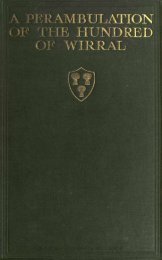Pagan Wirral – Myth or Reality? By Gavin Chappell - Old Wirral.com
Pagan Wirral – Myth or Reality? By Gavin Chappell - Old Wirral.com
Pagan Wirral – Myth or Reality? By Gavin Chappell - Old Wirral.com
Create successful ePaper yourself
Turn your PDF publications into a flip-book with our unique Google optimized e-Paper software.
<strong>Pagan</strong> Survivals<br />
But do genuine pagan survivals exist in <strong>Wirral</strong>? Further place name evidence reveals<br />
the existence of pre-Christian burial practices. The Arno in Oxton is not named after<br />
the famous Italian river, but rather represents a w<strong>or</strong>n-down f<strong>or</strong>m of the <strong>Old</strong> N<strong>or</strong>se<br />
Arnis-haugr, the ‘burial mound of Arni’, an otherwise unsung Viking. In Meols,<br />
meanwhile, we find F<strong>or</strong>nall Green, derived from F<strong>or</strong>n-haugr, the ‘ancient burial<br />
mound.’ In Birkenhead Park there were two burial mounds known locally as ‘the<br />
Bonks,’ which acc<strong>or</strong>ding to Caton’s Romance of <strong>Wirral</strong> were the scene of Easter<br />
celebrations by local children, which included rolling eggs up the mounds. Despite (<strong>or</strong><br />
perhaps due to) their popularity with children, these prehist<strong>or</strong>ic monuments became<br />
an eyes<strong>or</strong>e in the local council’s opinion, and were demolished.<br />
Up on Bidston Hill, near the Observat<strong>or</strong>y, are several rock carvings, including one of<br />
a h<strong>or</strong>se, reputedly facing towards the midsummer sunrise; one of a sun goddess; and<br />
another (very w<strong>or</strong>n) of a moon god. These are usually said to be the w<strong>or</strong>k of the<br />
Vikings, around 1000 AD. There is no real evidence f<strong>or</strong> this, although N<strong>or</strong>se<br />
mythology certainly includes a sun goddess, Sol, a moon god, Mani, and Arvakr, a<br />
h<strong>or</strong>se with solar connections. However, the date of 1000 AD seems too late f<strong>or</strong><br />
heathen N<strong>or</strong>semen in <strong>Wirral</strong>, being only a few decades pri<strong>or</strong> to the carving of the<br />
N<strong>or</strong>se crosses at West Kirby and elsewhere. The sparse evidence suggests that<br />
heathenism flourished in the tenth century, bef<strong>or</strong>e dying out in the eleventh <strong>–</strong> by the<br />
end of which century N<strong>or</strong>way and Denmark were both staunchly Christian.




